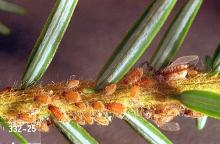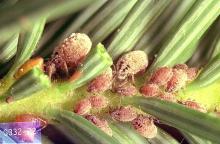Cinara occidentalis and Cinara abietis
Pest description and crop damage Cinara abietis are large, dark aphids typically feeding on upper stems and tended by ants. May distort stems. Cinara occidentalis feed at the base of needles on 1-year and older foliage, often in the lower portion of the tree and may be quite damaging.
See table:
Hosts and Symptoms of Major Aphid and Adelgid Pests of Christmas Trees
Management-cultural control
Cinara abietis is easily spotted and often controlled by squishing colonies by hand or spot spraying. Minor outbreaks of both species may be kept in check with beneficial insect predators or spot treatments.
Management-chemical control
- afidopyropen (Ventigra) (Subgroup 9D)-Not permitted in Oregon
- azadirachtin (AzaDirect and others)-Some formulations are OMRI-listed for organic use.
- bifenthrin (OnyxPro, Sniper and others) (Group 3)-Restricted use pesticide
- Chromobacterium subtsugae (Grandevo)-OMRI-listed for organic use.
- cyantraniliprole (Mainspring GNL, Exirel) (Group 28)
- cyclaniliprole + flonicamid (Pradia) (Group 28 + Group 29)
- dinotefuran (Safari 20 SG) (Group 4A)
- flupyradifurone (Altus) (Group 4D)
- imidacloprid (Montana, Nuprid 4F and others) (Group 4A)
- insecticidal soaps and oils (Ecotec, M-pede, 440 Superior Oil, Ultra-Pure Oil and others)-Test for phytotoxicity for any new oil product prior to widespread use. Some formulations are OMRI-listed for organic use.
- malathion (organophosphate) (various formulations) (Group 1B)
- pymetrozine (Endeavor and others) (Group 9)
- spirotetramet (Movento) (Group 23)
- sulfoxaflor (Transform WG) (Group 4C)
- thiamethoxam (Flagship 25 WG) (Group 4A)
Management-biological control
- aphid predators (Aphidoletes aphidimyza, Aphidius spp., Hippodamia spp., Chrysopa spp.)-Consider attracting predators with forage plantings and using products with low toxicity to predators.
See:


